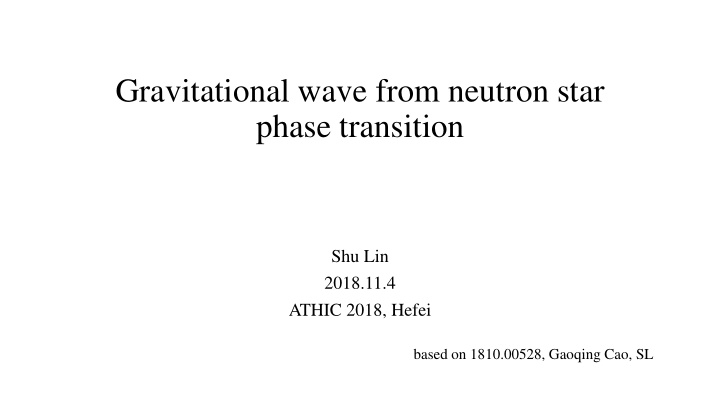



Gravitational wave from neutron star phase transition Shu Lin 2018.11.4 ATHIC 2018, Hefei based on 1810.00528, Gaoqing Cao, SL
Outline • Introduction • GW from binary neutron star merger • GW generation from nuclear/quark matter phase transition • GW as a probe of the phase transition • Summary&outlook
Equation of state of NS EOS of NS not accessible by first principle lattice simulation A variety of phenomenological EOS exist
Possible quark matter in core of NS
GW radiation as a new messenger: NS merger GW170817: first observation of GW signal from binary NS merger GW frequencies: ~10-~100Hz LIGO and Virgo: PRL 119, (2017)
Constraining power of GW Tidal deformability: Annala, Gorda, Kurkela, Vuorinen, PRL (2018) Nuclear symmetry energy: Zhang, Li, 1807.07698 Signature of quark matter phase: Most, Jens Papenfort, Dexheimer, Hanauske, Schramm, Stocker, Rezzolla, 1807.03684 This work is about another source of GW radiation: phase transition itself
GW from phase transition in early universe First order phase transition in early universe: phase transition proceeds with nucleation of bubbles in supercooled phase False True Kosowsky, Turner, Watkins, PRD (1992), PRL (1992)
GW from nuclear/quark matter phase transition False True If nuclear/quark matter transition is first order, and over-compressed phase is realized, it also generates GW! 1810.00528, Gaoqing Cao, SL
Mechanism of GW generation in FPT Effective potential for 𝜏 Over compression of NS by gravitational collapse at supernova explosion or afterward part of energy released in the 𝑑 = 957𝑁𝑓𝑊 𝜈 𝐶 form of GW true vacuum(QM) false vacuum(NM)
Bubble nucleation in first order phase transition Bubble nucleation in false vacuum: O(4) symmetric Euclidean solution Coleman, PRD (1977) Callan, Coleman, PRD (1977) False True Probability of nucleation rate
Bubble dynamics Bubbles expand classically and collide with each other, radiating GW. Kosowsky, Turner, Watkins, PRD (1992), PRL (1992) Kosowsky, Turner, PRD (1993)
Volume and duration of PT Simple model of NS profile 𝑆 𝑑 = 1𝑙𝑛 (inner core of NS), 𝑈 = 𝑆 𝑑 /𝑑 (expansion with speed of light)
Nucleation rate Bubble nucleation is random, following Poisson distribution: Guth, PRD (1981) Average number of bubbles: significant nucleation only for ∆𝜈 𝐶 ≳ 14𝑁𝑓𝑊 low nucleation rate favors for over-compression
Scenarios of phase transition Few-bubble scenario Many-bubble scenario
Generic features of GW in NS phase transition GW strain GW energy spectrum characteristic frequency of GW 𝜕~ 2𝜌 𝑈 = 2𝜌𝑑 ~6𝜌 × 10 5 𝑠𝑏𝑒/𝑡 𝑆 𝑑 duration of GW pulse ∆𝑢~𝑆 𝑑 /c
Few-bubble vs Many-bubble One-bubble case, two As number of bubbles increase, the strain and energy polarizations in phase decreases, with the energy spectrum spans a wider region
Detectability of GW Characteristic frequency 𝜕~6𝜌 × 10 5 𝑠𝑏𝑒/𝑡 distinguishes from other sources Strain ℎ~10 −25 − 10 −24 for 𝑀 = 0.1𝑁𝑞𝑑 . Larger strain for larger quark matter core and nearer NS Damping rate of GW by outer nuclear matter core ~ 0.03 GW can escape from the NS Baym, Patilm Pethick, PRD (2017)
Summary & Outlook GW from neutron star phase transition carries information about the transition: • Order of phase transition • Radius of quark matter core 𝑆 𝑑 ~2𝜌𝑑/𝜕 • Latent energy density 𝜁 𝑊 ∝ ℎ • GW waveform implies scenario of bubble nucleation 𝜁 𝑊 • GW spectrum modification due to interaction (jet-medium interaction) • EM radiation or neutrino radiation from phase transition?
Thank you!
Recommend
More recommend